Comprehensive Briefing Paper: HIV Risk Assessment and Management
VerifiedAdded on 2023/06/09
|12
|4350
|141
Report
AI Summary
This report provides a comprehensive risk assessment and management analysis of HIV in Africa. It begins with an introduction to HIV, its transmission, and its impact on the African population. The risk assessment section covers hazard identification, including factors like poverty, STDs, and drug use, as well as hazard characterization, discussing the dose-response assessment of antiretroviral drugs and their side effects. A risk assessment matrix is used to evaluate the likelihood and consequences of HIV infection. The exposure assessment examines social determinants and environmental factors influencing HIV transmission. The risk management section likely details prevention strategies, treatment options, and public health interventions. The report concludes with recommendations for improving HIV control and prevention efforts in Africa. Desklib provides access to this and other solved assignments to aid students in their studies.
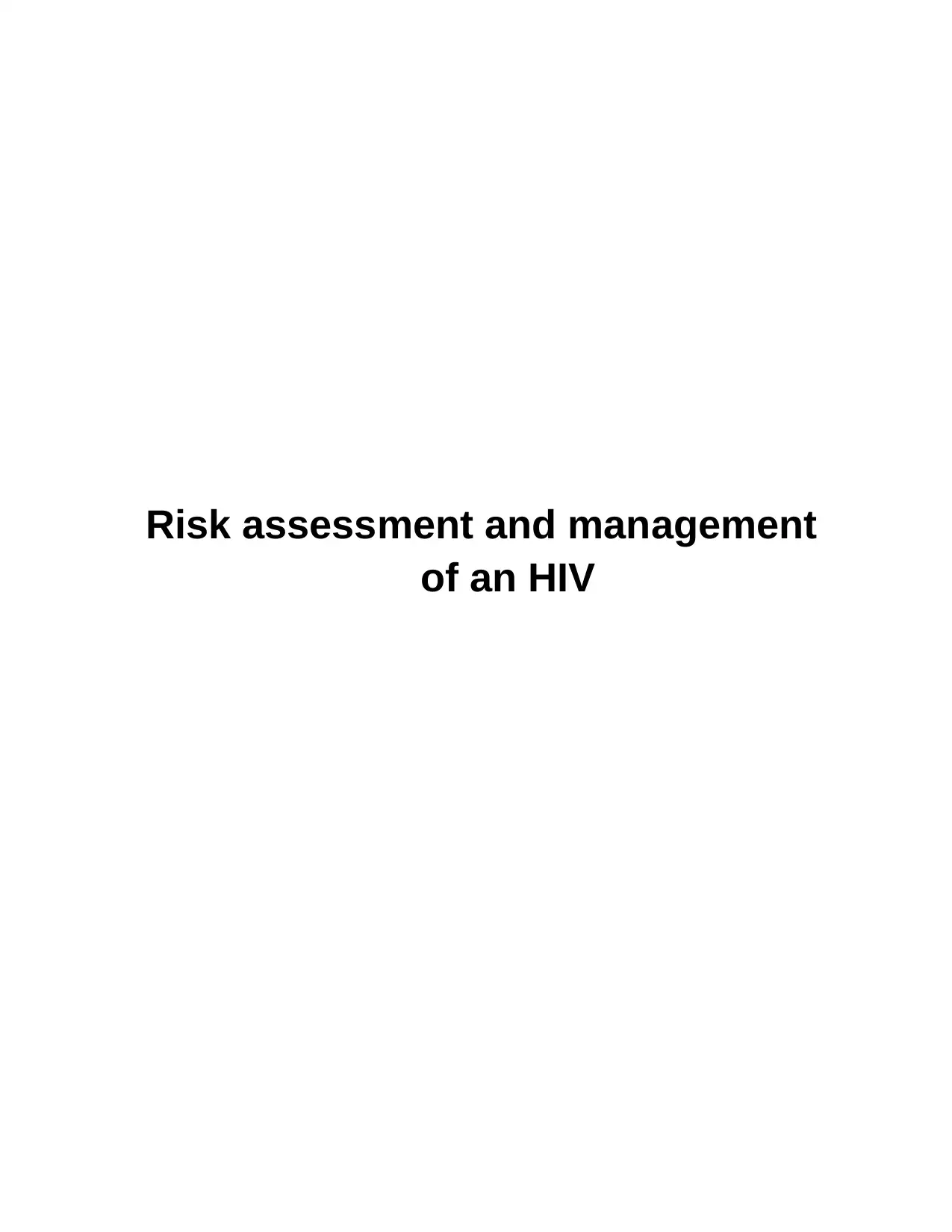
Risk assessment and management
of an HIV
of an HIV
Paraphrase This Document
Need a fresh take? Get an instant paraphrase of this document with our AI Paraphraser
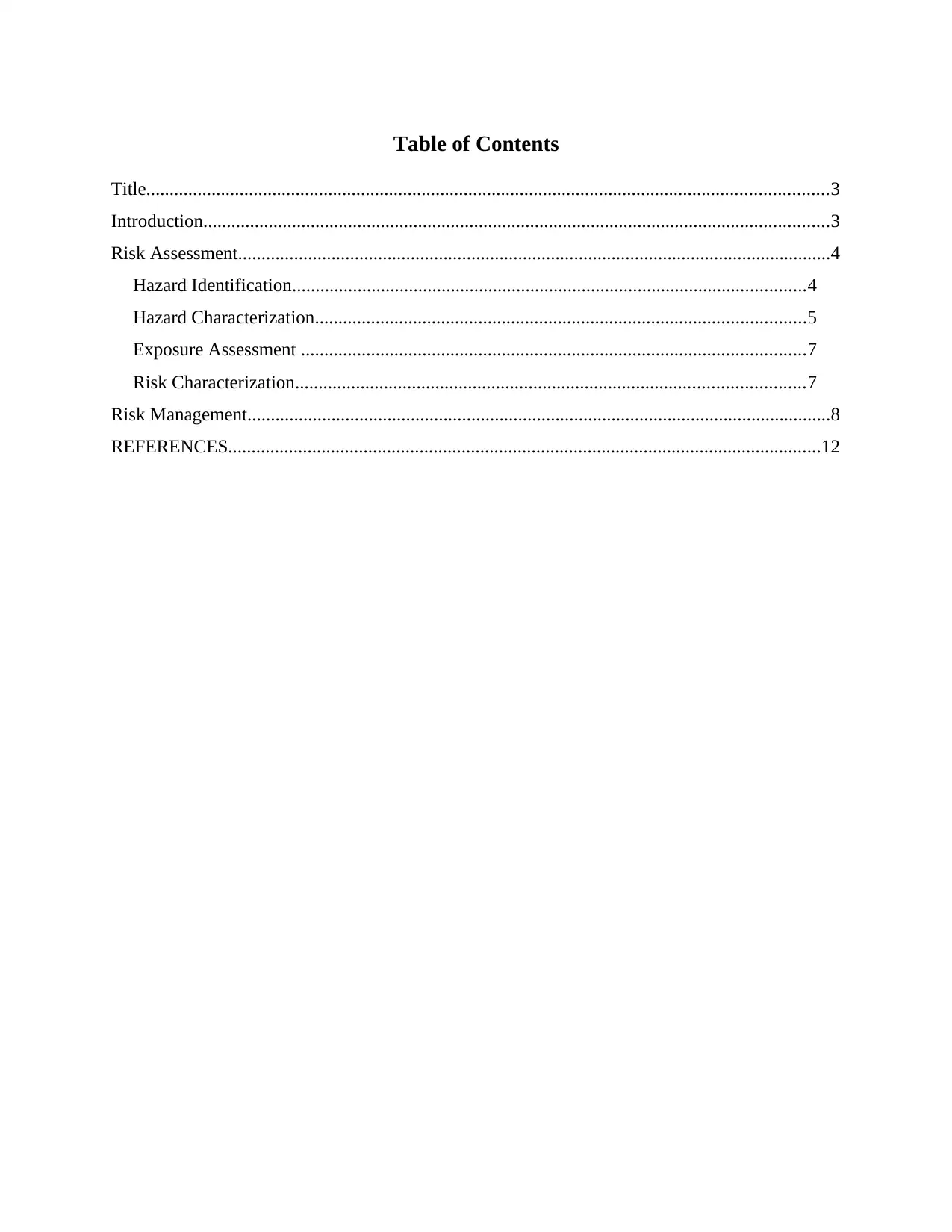
Table of Contents
Title..................................................................................................................................................3
Introduction......................................................................................................................................3
Risk Assessment...............................................................................................................................4
Hazard Identification..............................................................................................................4
Hazard Characterization.........................................................................................................5
Exposure Assessment ............................................................................................................7
Risk Characterization.............................................................................................................7
Risk Management.............................................................................................................................8
REFERENCES...............................................................................................................................12
Title..................................................................................................................................................3
Introduction......................................................................................................................................3
Risk Assessment...............................................................................................................................4
Hazard Identification..............................................................................................................4
Hazard Characterization.........................................................................................................5
Exposure Assessment ............................................................................................................7
Risk Characterization.............................................................................................................7
Risk Management.............................................................................................................................8
REFERENCES...............................................................................................................................12
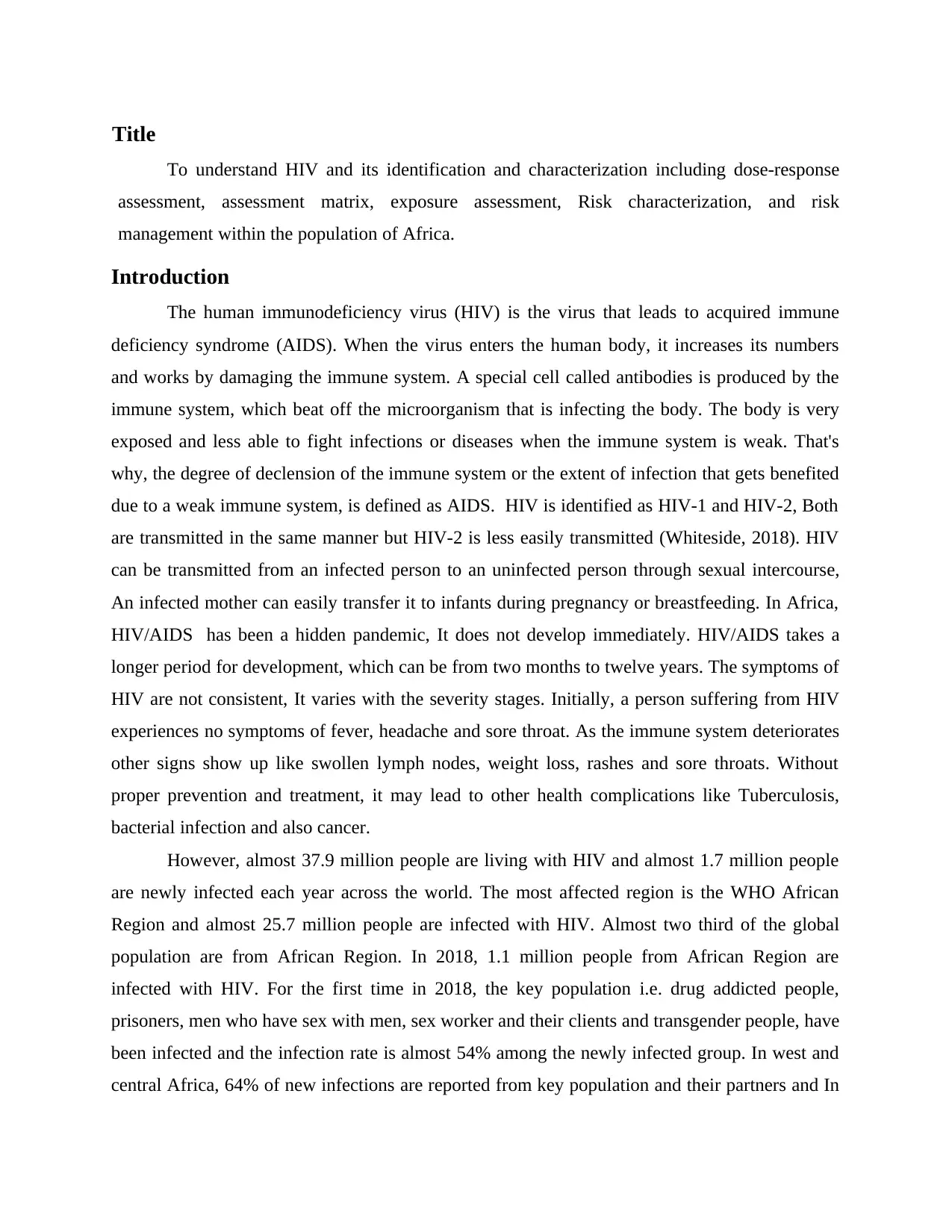
Title
To understand HIV and its identification and characterization including dose-response
assessment, assessment matrix, exposure assessment, Risk characterization, and risk
management within the population of Africa.
Introduction
The human immunodeficiency virus (HIV) is the virus that leads to acquired immune
deficiency syndrome (AIDS). When the virus enters the human body, it increases its numbers
and works by damaging the immune system. A special cell called antibodies is produced by the
immune system, which beat off the microorganism that is infecting the body. The body is very
exposed and less able to fight infections or diseases when the immune system is weak. That's
why, the degree of declension of the immune system or the extent of infection that gets benefited
due to a weak immune system, is defined as AIDS. HIV is identified as HIV-1 and HIV-2, Both
are transmitted in the same manner but HIV-2 is less easily transmitted (Whiteside, 2018). HIV
can be transmitted from an infected person to an uninfected person through sexual intercourse,
An infected mother can easily transfer it to infants during pregnancy or breastfeeding. In Africa,
HIV/AIDS has been a hidden pandemic, It does not develop immediately. HIV/AIDS takes a
longer period for development, which can be from two months to twelve years. The symptoms of
HIV are not consistent, It varies with the severity stages. Initially, a person suffering from HIV
experiences no symptoms of fever, headache and sore throat. As the immune system deteriorates
other signs show up like swollen lymph nodes, weight loss, rashes and sore throats. Without
proper prevention and treatment, it may lead to other health complications like Tuberculosis,
bacterial infection and also cancer.
However, almost 37.9 million people are living with HIV and almost 1.7 million people
are newly infected each year across the world. The most affected region is the WHO African
Region and almost 25.7 million people are infected with HIV. Almost two third of the global
population are from African Region. In 2018, 1.1 million people from African Region are
infected with HIV. For the first time in 2018, the key population i.e. drug addicted people,
prisoners, men who have sex with men, sex worker and their clients and transgender people, have
been infected and the infection rate is almost 54% among the newly infected group. In west and
central Africa, 64% of new infections are reported from key population and their partners and In
To understand HIV and its identification and characterization including dose-response
assessment, assessment matrix, exposure assessment, Risk characterization, and risk
management within the population of Africa.
Introduction
The human immunodeficiency virus (HIV) is the virus that leads to acquired immune
deficiency syndrome (AIDS). When the virus enters the human body, it increases its numbers
and works by damaging the immune system. A special cell called antibodies is produced by the
immune system, which beat off the microorganism that is infecting the body. The body is very
exposed and less able to fight infections or diseases when the immune system is weak. That's
why, the degree of declension of the immune system or the extent of infection that gets benefited
due to a weak immune system, is defined as AIDS. HIV is identified as HIV-1 and HIV-2, Both
are transmitted in the same manner but HIV-2 is less easily transmitted (Whiteside, 2018). HIV
can be transmitted from an infected person to an uninfected person through sexual intercourse,
An infected mother can easily transfer it to infants during pregnancy or breastfeeding. In Africa,
HIV/AIDS has been a hidden pandemic, It does not develop immediately. HIV/AIDS takes a
longer period for development, which can be from two months to twelve years. The symptoms of
HIV are not consistent, It varies with the severity stages. Initially, a person suffering from HIV
experiences no symptoms of fever, headache and sore throat. As the immune system deteriorates
other signs show up like swollen lymph nodes, weight loss, rashes and sore throats. Without
proper prevention and treatment, it may lead to other health complications like Tuberculosis,
bacterial infection and also cancer.
However, almost 37.9 million people are living with HIV and almost 1.7 million people
are newly infected each year across the world. The most affected region is the WHO African
Region and almost 25.7 million people are infected with HIV. Almost two third of the global
population are from African Region. In 2018, 1.1 million people from African Region are
infected with HIV. For the first time in 2018, the key population i.e. drug addicted people,
prisoners, men who have sex with men, sex worker and their clients and transgender people, have
been infected and the infection rate is almost 54% among the newly infected group. In west and
central Africa, 64% of new infections are reported from key population and their partners and In
⊘ This is a preview!⊘
Do you want full access?
Subscribe today to unlock all pages.

Trusted by 1+ million students worldwide
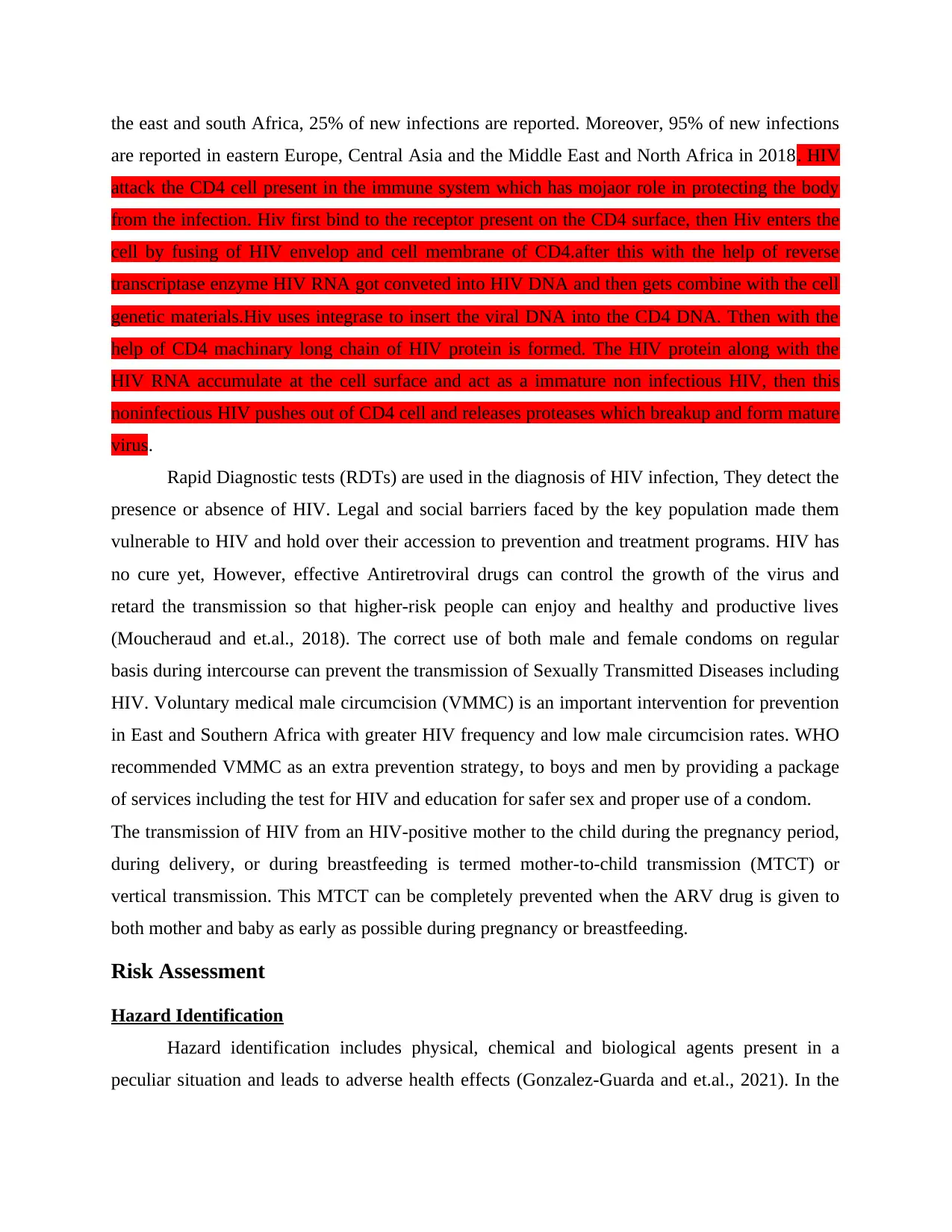
the east and south Africa, 25% of new infections are reported. Moreover, 95% of new infections
are reported in eastern Europe, Central Asia and the Middle East and North Africa in 2018. HIV
attack the CD4 cell present in the immune system which has mojaor role in protecting the body
from the infection. Hiv first bind to the receptor present on the CD4 surface, then Hiv enters the
cell by fusing of HIV envelop and cell membrane of CD4.after this with the help of reverse
transcriptase enzyme HIV RNA got conveted into HIV DNA and then gets combine with the cell
genetic materials.Hiv uses integrase to insert the viral DNA into the CD4 DNA. Tthen with the
help of CD4 machinary long chain of HIV protein is formed. The HIV protein along with the
HIV RNA accumulate at the cell surface and act as a immature non infectious HIV, then this
noninfectious HIV pushes out of CD4 cell and releases proteases which breakup and form mature
virus.
Rapid Diagnostic tests (RDTs) are used in the diagnosis of HIV infection, They detect the
presence or absence of HIV. Legal and social barriers faced by the key population made them
vulnerable to HIV and hold over their accession to prevention and treatment programs. HIV has
no cure yet, However, effective Antiretroviral drugs can control the growth of the virus and
retard the transmission so that higher-risk people can enjoy and healthy and productive lives
(Moucheraud and et.al., 2018). The correct use of both male and female condoms on regular
basis during intercourse can prevent the transmission of Sexually Transmitted Diseases including
HIV. Voluntary medical male circumcision (VMMC) is an important intervention for prevention
in East and Southern Africa with greater HIV frequency and low male circumcision rates. WHO
recommended VMMC as an extra prevention strategy, to boys and men by providing a package
of services including the test for HIV and education for safer sex and proper use of a condom.
The transmission of HIV from an HIV-positive mother to the child during the pregnancy period,
during delivery, or during breastfeeding is termed mother-to-child transmission (MTCT) or
vertical transmission. This MTCT can be completely prevented when the ARV drug is given to
both mother and baby as early as possible during pregnancy or breastfeeding.
Risk Assessment
Hazard Identification
Hazard identification includes physical, chemical and biological agents present in a
peculiar situation and leads to adverse health effects (Gonzalez-Guarda and et.al., 2021). In the
are reported in eastern Europe, Central Asia and the Middle East and North Africa in 2018. HIV
attack the CD4 cell present in the immune system which has mojaor role in protecting the body
from the infection. Hiv first bind to the receptor present on the CD4 surface, then Hiv enters the
cell by fusing of HIV envelop and cell membrane of CD4.after this with the help of reverse
transcriptase enzyme HIV RNA got conveted into HIV DNA and then gets combine with the cell
genetic materials.Hiv uses integrase to insert the viral DNA into the CD4 DNA. Tthen with the
help of CD4 machinary long chain of HIV protein is formed. The HIV protein along with the
HIV RNA accumulate at the cell surface and act as a immature non infectious HIV, then this
noninfectious HIV pushes out of CD4 cell and releases proteases which breakup and form mature
virus.
Rapid Diagnostic tests (RDTs) are used in the diagnosis of HIV infection, They detect the
presence or absence of HIV. Legal and social barriers faced by the key population made them
vulnerable to HIV and hold over their accession to prevention and treatment programs. HIV has
no cure yet, However, effective Antiretroviral drugs can control the growth of the virus and
retard the transmission so that higher-risk people can enjoy and healthy and productive lives
(Moucheraud and et.al., 2018). The correct use of both male and female condoms on regular
basis during intercourse can prevent the transmission of Sexually Transmitted Diseases including
HIV. Voluntary medical male circumcision (VMMC) is an important intervention for prevention
in East and Southern Africa with greater HIV frequency and low male circumcision rates. WHO
recommended VMMC as an extra prevention strategy, to boys and men by providing a package
of services including the test for HIV and education for safer sex and proper use of a condom.
The transmission of HIV from an HIV-positive mother to the child during the pregnancy period,
during delivery, or during breastfeeding is termed mother-to-child transmission (MTCT) or
vertical transmission. This MTCT can be completely prevented when the ARV drug is given to
both mother and baby as early as possible during pregnancy or breastfeeding.
Risk Assessment
Hazard Identification
Hazard identification includes physical, chemical and biological agents present in a
peculiar situation and leads to adverse health effects (Gonzalez-Guarda and et.al., 2021). In the
Paraphrase This Document
Need a fresh take? Get an instant paraphrase of this document with our AI Paraphraser
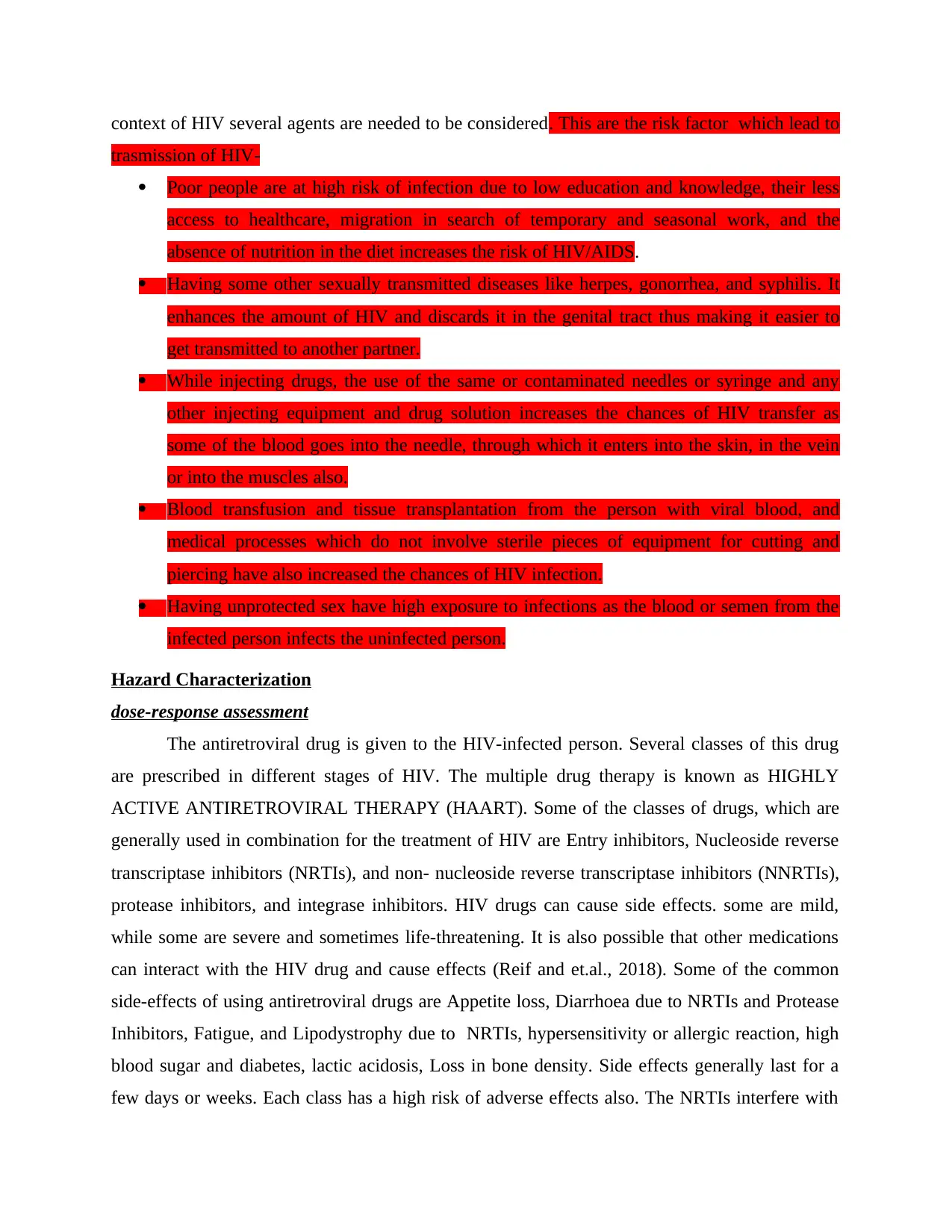
context of HIV several agents are needed to be considered. This are the risk factor which lead to
trasmission of HIV-
Poor people are at high risk of infection due to low education and knowledge, their less
access to healthcare, migration in search of temporary and seasonal work, and the
absence of nutrition in the diet increases the risk of HIV/AIDS.
Having some other sexually transmitted diseases like herpes, gonorrhea, and syphilis. It
enhances the amount of HIV and discards it in the genital tract thus making it easier to
get transmitted to another partner.
While injecting drugs, the use of the same or contaminated needles or syringe and any
other injecting equipment and drug solution increases the chances of HIV transfer as
some of the blood goes into the needle, through which it enters into the skin, in the vein
or into the muscles also.
Blood transfusion and tissue transplantation from the person with viral blood, and
medical processes which do not involve sterile pieces of equipment for cutting and
piercing have also increased the chances of HIV infection.
Having unprotected sex have high exposure to infections as the blood or semen from the
infected person infects the uninfected person.
Hazard Characterization
dose-response assessment
The antiretroviral drug is given to the HIV-infected person. Several classes of this drug
are prescribed in different stages of HIV. The multiple drug therapy is known as HIGHLY
ACTIVE ANTIRETROVIRAL THERAPY (HAART). Some of the classes of drugs, which are
generally used in combination for the treatment of HIV are Entry inhibitors, Nucleoside reverse
transcriptase inhibitors (NRTIs), and non- nucleoside reverse transcriptase inhibitors (NNRTIs),
protease inhibitors, and integrase inhibitors. HIV drugs can cause side effects. some are mild,
while some are severe and sometimes life-threatening. It is also possible that other medications
can interact with the HIV drug and cause effects (Reif and et.al., 2018). Some of the common
side-effects of using antiretroviral drugs are Appetite loss, Diarrhoea due to NRTIs and Protease
Inhibitors, Fatigue, and Lipodystrophy due to NRTIs, hypersensitivity or allergic reaction, high
blood sugar and diabetes, lactic acidosis, Loss in bone density. Side effects generally last for a
few days or weeks. Each class has a high risk of adverse effects also. The NRTIs interfere with
trasmission of HIV-
Poor people are at high risk of infection due to low education and knowledge, their less
access to healthcare, migration in search of temporary and seasonal work, and the
absence of nutrition in the diet increases the risk of HIV/AIDS.
Having some other sexually transmitted diseases like herpes, gonorrhea, and syphilis. It
enhances the amount of HIV and discards it in the genital tract thus making it easier to
get transmitted to another partner.
While injecting drugs, the use of the same or contaminated needles or syringe and any
other injecting equipment and drug solution increases the chances of HIV transfer as
some of the blood goes into the needle, through which it enters into the skin, in the vein
or into the muscles also.
Blood transfusion and tissue transplantation from the person with viral blood, and
medical processes which do not involve sterile pieces of equipment for cutting and
piercing have also increased the chances of HIV infection.
Having unprotected sex have high exposure to infections as the blood or semen from the
infected person infects the uninfected person.
Hazard Characterization
dose-response assessment
The antiretroviral drug is given to the HIV-infected person. Several classes of this drug
are prescribed in different stages of HIV. The multiple drug therapy is known as HIGHLY
ACTIVE ANTIRETROVIRAL THERAPY (HAART). Some of the classes of drugs, which are
generally used in combination for the treatment of HIV are Entry inhibitors, Nucleoside reverse
transcriptase inhibitors (NRTIs), and non- nucleoside reverse transcriptase inhibitors (NNRTIs),
protease inhibitors, and integrase inhibitors. HIV drugs can cause side effects. some are mild,
while some are severe and sometimes life-threatening. It is also possible that other medications
can interact with the HIV drug and cause effects (Reif and et.al., 2018). Some of the common
side-effects of using antiretroviral drugs are Appetite loss, Diarrhoea due to NRTIs and Protease
Inhibitors, Fatigue, and Lipodystrophy due to NRTIs, hypersensitivity or allergic reaction, high
blood sugar and diabetes, lactic acidosis, Loss in bone density. Side effects generally last for a
few days or weeks. Each class has a high risk of adverse effects also. The NRTIs interfere with
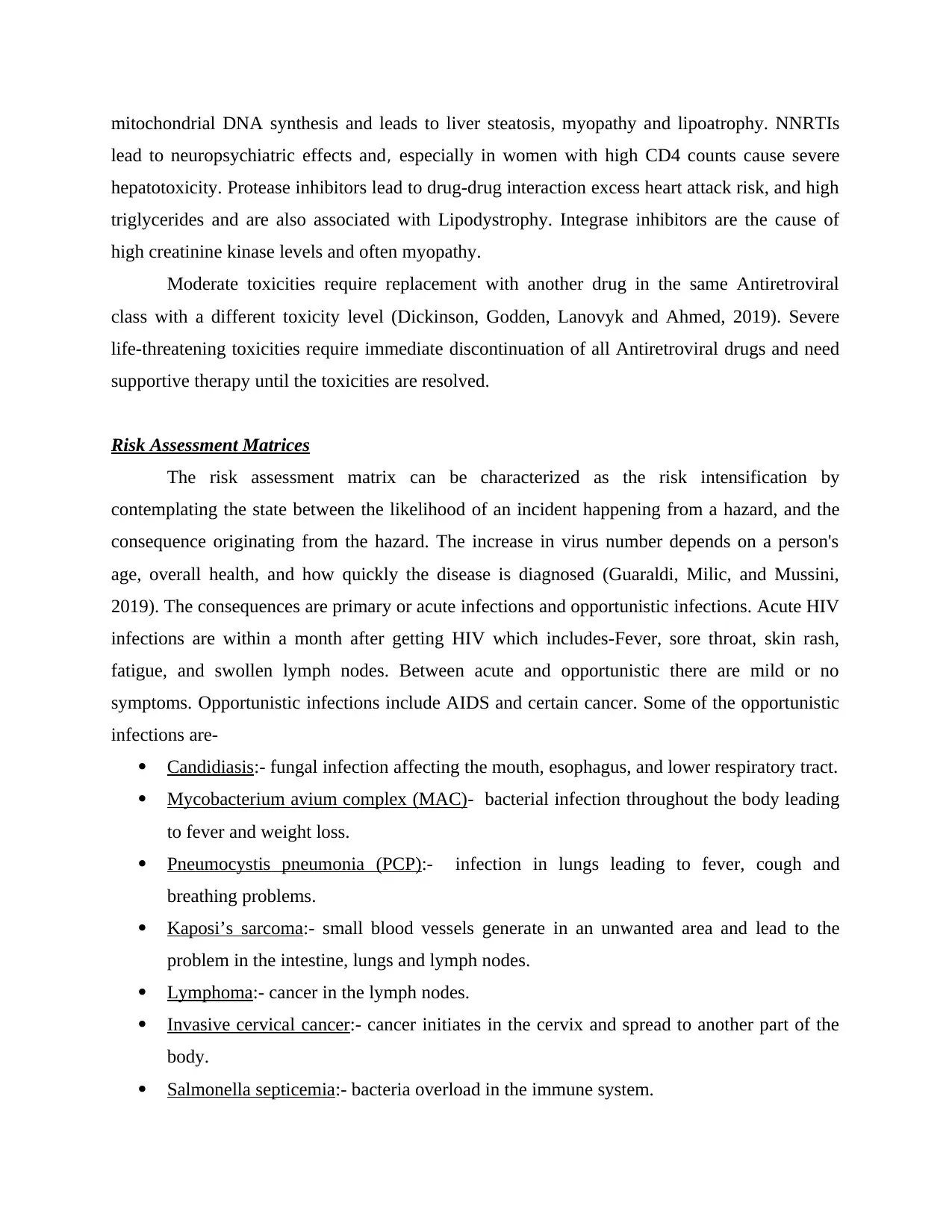
mitochondrial DNA synthesis and leads to liver steatosis, myopathy and lipoatrophy. NNRTIs
lead to neuropsychiatric effects and, especially in women with high CD4 counts cause severe
hepatotoxicity. Protease inhibitors lead to drug-drug interaction excess heart attack risk, and high
triglycerides and are also associated with Lipodystrophy. Integrase inhibitors are the cause of
high creatinine kinase levels and often myopathy.
Moderate toxicities require replacement with another drug in the same Antiretroviral
class with a different toxicity level (Dickinson, Godden, Lanovyk and Ahmed, 2019). Severe
life-threatening toxicities require immediate discontinuation of all Antiretroviral drugs and need
supportive therapy until the toxicities are resolved.
Risk Assessment Matrices
The risk assessment matrix can be characterized as the risk intensification by
contemplating the state between the likelihood of an incident happening from a hazard, and the
consequence originating from the hazard. The increase in virus number depends on a person's
age, overall health, and how quickly the disease is diagnosed (Guaraldi, Milic, and Mussini,
2019). The consequences are primary or acute infections and opportunistic infections. Acute HIV
infections are within a month after getting HIV which includes-Fever, sore throat, skin rash,
fatigue, and swollen lymph nodes. Between acute and opportunistic there are mild or no
symptoms. Opportunistic infections include AIDS and certain cancer. Some of the opportunistic
infections are-
Candidiasis:- fungal infection affecting the mouth, esophagus, and lower respiratory tract.
Mycobacterium avium complex (MAC)- bacterial infection throughout the body leading
to fever and weight loss.
Pneumocystis pneumonia (PCP):- infection in lungs leading to fever, cough and
breathing problems.
Kaposi’s sarcoma:- small blood vessels generate in an unwanted area and lead to the
problem in the intestine, lungs and lymph nodes.
Lymphoma:- cancer in the lymph nodes.
Invasive cervical cancer:- cancer initiates in the cervix and spread to another part of the
body.
Salmonella septicemia:- bacteria overload in the immune system.
lead to neuropsychiatric effects and, especially in women with high CD4 counts cause severe
hepatotoxicity. Protease inhibitors lead to drug-drug interaction excess heart attack risk, and high
triglycerides and are also associated with Lipodystrophy. Integrase inhibitors are the cause of
high creatinine kinase levels and often myopathy.
Moderate toxicities require replacement with another drug in the same Antiretroviral
class with a different toxicity level (Dickinson, Godden, Lanovyk and Ahmed, 2019). Severe
life-threatening toxicities require immediate discontinuation of all Antiretroviral drugs and need
supportive therapy until the toxicities are resolved.
Risk Assessment Matrices
The risk assessment matrix can be characterized as the risk intensification by
contemplating the state between the likelihood of an incident happening from a hazard, and the
consequence originating from the hazard. The increase in virus number depends on a person's
age, overall health, and how quickly the disease is diagnosed (Guaraldi, Milic, and Mussini,
2019). The consequences are primary or acute infections and opportunistic infections. Acute HIV
infections are within a month after getting HIV which includes-Fever, sore throat, skin rash,
fatigue, and swollen lymph nodes. Between acute and opportunistic there are mild or no
symptoms. Opportunistic infections include AIDS and certain cancer. Some of the opportunistic
infections are-
Candidiasis:- fungal infection affecting the mouth, esophagus, and lower respiratory tract.
Mycobacterium avium complex (MAC)- bacterial infection throughout the body leading
to fever and weight loss.
Pneumocystis pneumonia (PCP):- infection in lungs leading to fever, cough and
breathing problems.
Kaposi’s sarcoma:- small blood vessels generate in an unwanted area and lead to the
problem in the intestine, lungs and lymph nodes.
Lymphoma:- cancer in the lymph nodes.
Invasive cervical cancer:- cancer initiates in the cervix and spread to another part of the
body.
Salmonella septicemia:- bacteria overload in the immune system.
⊘ This is a preview!⊘
Do you want full access?
Subscribe today to unlock all pages.

Trusted by 1+ million students worldwide
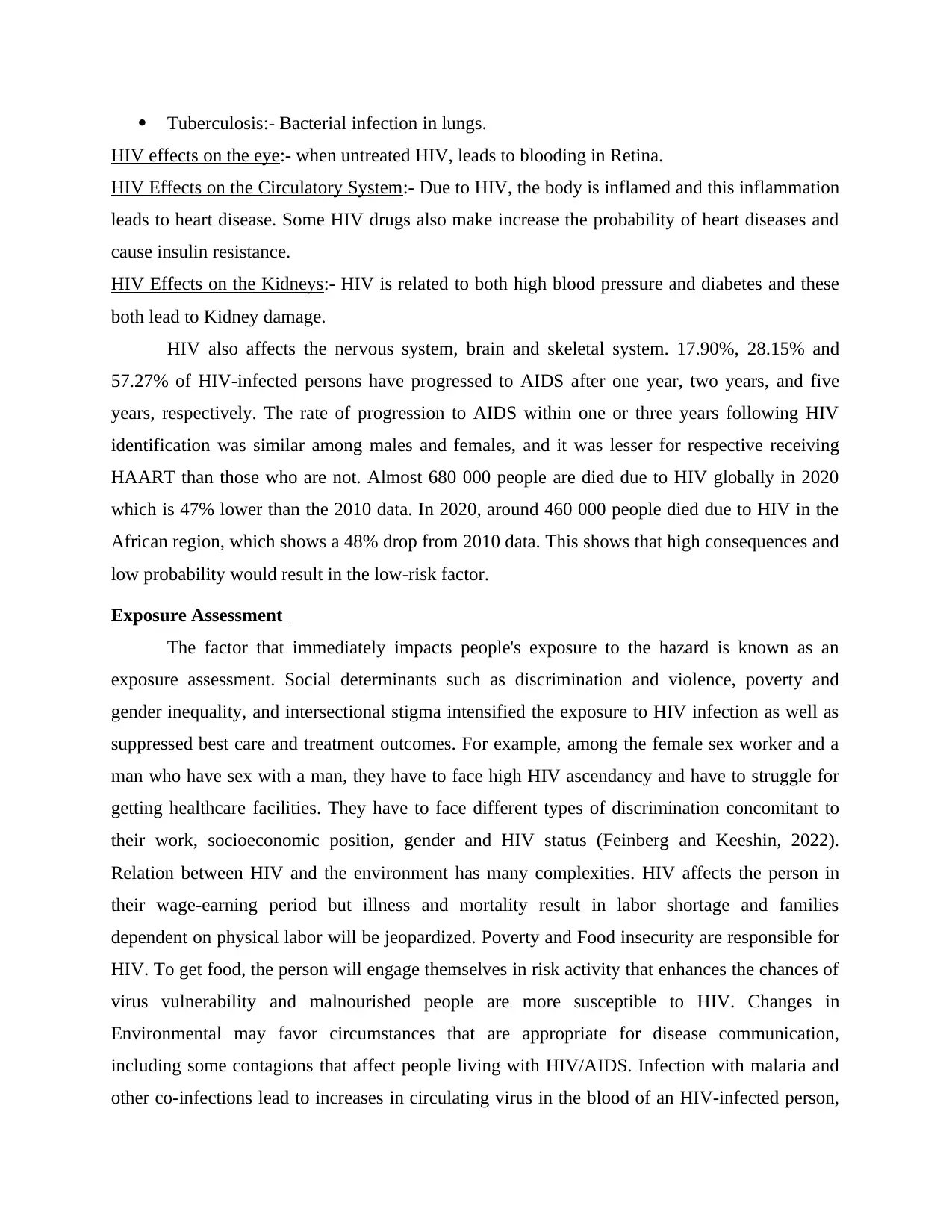
Tuberculosis:- Bacterial infection in lungs.
HIV effects on the eye:- when untreated HIV, leads to blooding in Retina.
HIV Effects on the Circulatory System:- Due to HIV, the body is inflamed and this inflammation
leads to heart disease. Some HIV drugs also make increase the probability of heart diseases and
cause insulin resistance.
HIV Effects on the Kidneys:- HIV is related to both high blood pressure and diabetes and these
both lead to Kidney damage.
HIV also affects the nervous system, brain and skeletal system. 17.90%, 28.15% and
57.27% of HIV-infected persons have progressed to AIDS after one year, two years, and five
years, respectively. The rate of progression to AIDS within one or three years following HIV
identification was similar among males and females, and it was lesser for respective receiving
HAART than those who are not. Almost 680 000 people are died due to HIV globally in 2020
which is 47% lower than the 2010 data. In 2020, around 460 000 people died due to HIV in the
African region, which shows a 48% drop from 2010 data. This shows that high consequences and
low probability would result in the low-risk factor.
Exposure Assessment
The factor that immediately impacts people's exposure to the hazard is known as an
exposure assessment. Social determinants such as discrimination and violence, poverty and
gender inequality, and intersectional stigma intensified the exposure to HIV infection as well as
suppressed best care and treatment outcomes. For example, among the female sex worker and a
man who have sex with a man, they have to face high HIV ascendancy and have to struggle for
getting healthcare facilities. They have to face different types of discrimination concomitant to
their work, socioeconomic position, gender and HIV status (Feinberg and Keeshin, 2022).
Relation between HIV and the environment has many complexities. HIV affects the person in
their wage-earning period but illness and mortality result in labor shortage and families
dependent on physical labor will be jeopardized. Poverty and Food insecurity are responsible for
HIV. To get food, the person will engage themselves in risk activity that enhances the chances of
virus vulnerability and malnourished people are more susceptible to HIV. Changes in
Environmental may favor circumstances that are appropriate for disease communication,
including some contagions that affect people living with HIV/AIDS. Infection with malaria and
other co-infections lead to increases in circulating virus in the blood of an HIV-infected person,
HIV effects on the eye:- when untreated HIV, leads to blooding in Retina.
HIV Effects on the Circulatory System:- Due to HIV, the body is inflamed and this inflammation
leads to heart disease. Some HIV drugs also make increase the probability of heart diseases and
cause insulin resistance.
HIV Effects on the Kidneys:- HIV is related to both high blood pressure and diabetes and these
both lead to Kidney damage.
HIV also affects the nervous system, brain and skeletal system. 17.90%, 28.15% and
57.27% of HIV-infected persons have progressed to AIDS after one year, two years, and five
years, respectively. The rate of progression to AIDS within one or three years following HIV
identification was similar among males and females, and it was lesser for respective receiving
HAART than those who are not. Almost 680 000 people are died due to HIV globally in 2020
which is 47% lower than the 2010 data. In 2020, around 460 000 people died due to HIV in the
African region, which shows a 48% drop from 2010 data. This shows that high consequences and
low probability would result in the low-risk factor.
Exposure Assessment
The factor that immediately impacts people's exposure to the hazard is known as an
exposure assessment. Social determinants such as discrimination and violence, poverty and
gender inequality, and intersectional stigma intensified the exposure to HIV infection as well as
suppressed best care and treatment outcomes. For example, among the female sex worker and a
man who have sex with a man, they have to face high HIV ascendancy and have to struggle for
getting healthcare facilities. They have to face different types of discrimination concomitant to
their work, socioeconomic position, gender and HIV status (Feinberg and Keeshin, 2022).
Relation between HIV and the environment has many complexities. HIV affects the person in
their wage-earning period but illness and mortality result in labor shortage and families
dependent on physical labor will be jeopardized. Poverty and Food insecurity are responsible for
HIV. To get food, the person will engage themselves in risk activity that enhances the chances of
virus vulnerability and malnourished people are more susceptible to HIV. Changes in
Environmental may favor circumstances that are appropriate for disease communication,
including some contagions that affect people living with HIV/AIDS. Infection with malaria and
other co-infections lead to increases in circulating virus in the blood of an HIV-infected person,
Paraphrase This Document
Need a fresh take? Get an instant paraphrase of this document with our AI Paraphraser
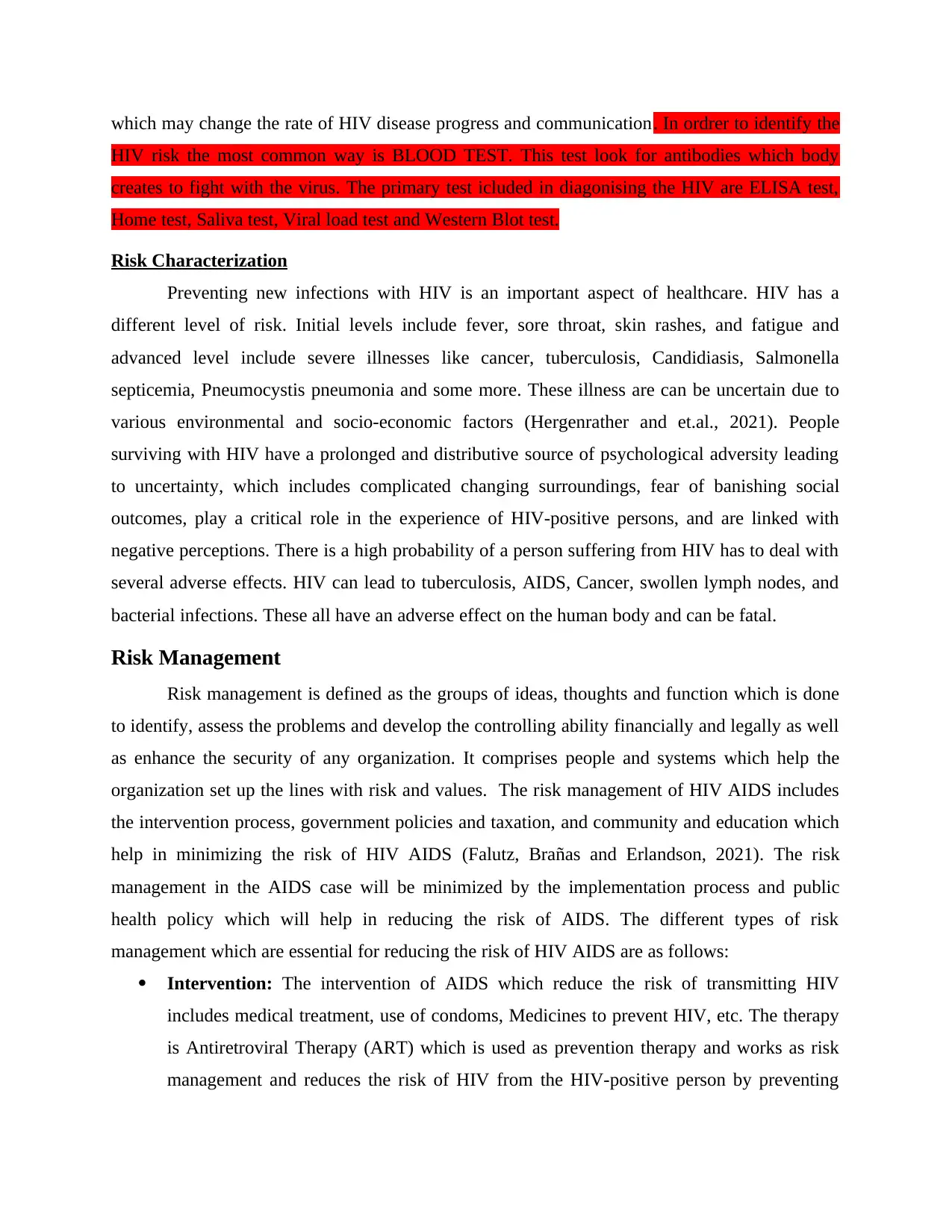
which may change the rate of HIV disease progress and communication. In ordrer to identify the
HIV risk the most common way is BLOOD TEST. This test look for antibodies which body
creates to fight with the virus. The primary test icluded in diagonising the HIV are ELISA test,
Home test, Saliva test, Viral load test and Western Blot test.
Risk Characterization
Preventing new infections with HIV is an important aspect of healthcare. HIV has a
different level of risk. Initial levels include fever, sore throat, skin rashes, and fatigue and
advanced level include severe illnesses like cancer, tuberculosis, Candidiasis, Salmonella
septicemia, Pneumocystis pneumonia and some more. These illness are can be uncertain due to
various environmental and socio-economic factors (Hergenrather and et.al., 2021). People
surviving with HIV have a prolonged and distributive source of psychological adversity leading
to uncertainty, which includes complicated changing surroundings, fear of banishing social
outcomes, play a critical role in the experience of HIV-positive persons, and are linked with
negative perceptions. There is a high probability of a person suffering from HIV has to deal with
several adverse effects. HIV can lead to tuberculosis, AIDS, Cancer, swollen lymph nodes, and
bacterial infections. These all have an adverse effect on the human body and can be fatal.
Risk Management
Risk management is defined as the groups of ideas, thoughts and function which is done
to identify, assess the problems and develop the controlling ability financially and legally as well
as enhance the security of any organization. It comprises people and systems which help the
organization set up the lines with risk and values. The risk management of HIV AIDS includes
the intervention process, government policies and taxation, and community and education which
help in minimizing the risk of HIV AIDS (Falutz, Brañas and Erlandson, 2021). The risk
management in the AIDS case will be minimized by the implementation process and public
health policy which will help in reducing the risk of AIDS. The different types of risk
management which are essential for reducing the risk of HIV AIDS are as follows:
Intervention: The intervention of AIDS which reduce the risk of transmitting HIV
includes medical treatment, use of condoms, Medicines to prevent HIV, etc. The therapy
is Antiretroviral Therapy (ART) which is used as prevention therapy and works as risk
management and reduces the risk of HIV from the HIV-positive person by preventing
HIV risk the most common way is BLOOD TEST. This test look for antibodies which body
creates to fight with the virus. The primary test icluded in diagonising the HIV are ELISA test,
Home test, Saliva test, Viral load test and Western Blot test.
Risk Characterization
Preventing new infections with HIV is an important aspect of healthcare. HIV has a
different level of risk. Initial levels include fever, sore throat, skin rashes, and fatigue and
advanced level include severe illnesses like cancer, tuberculosis, Candidiasis, Salmonella
septicemia, Pneumocystis pneumonia and some more. These illness are can be uncertain due to
various environmental and socio-economic factors (Hergenrather and et.al., 2021). People
surviving with HIV have a prolonged and distributive source of psychological adversity leading
to uncertainty, which includes complicated changing surroundings, fear of banishing social
outcomes, play a critical role in the experience of HIV-positive persons, and are linked with
negative perceptions. There is a high probability of a person suffering from HIV has to deal with
several adverse effects. HIV can lead to tuberculosis, AIDS, Cancer, swollen lymph nodes, and
bacterial infections. These all have an adverse effect on the human body and can be fatal.
Risk Management
Risk management is defined as the groups of ideas, thoughts and function which is done
to identify, assess the problems and develop the controlling ability financially and legally as well
as enhance the security of any organization. It comprises people and systems which help the
organization set up the lines with risk and values. The risk management of HIV AIDS includes
the intervention process, government policies and taxation, and community and education which
help in minimizing the risk of HIV AIDS (Falutz, Brañas and Erlandson, 2021). The risk
management in the AIDS case will be minimized by the implementation process and public
health policy which will help in reducing the risk of AIDS. The different types of risk
management which are essential for reducing the risk of HIV AIDS are as follows:
Intervention: The intervention of AIDS which reduce the risk of transmitting HIV
includes medical treatment, use of condoms, Medicines to prevent HIV, etc. The therapy
is Antiretroviral Therapy (ART) which is used as prevention therapy and works as risk
management and reduces the risk of HIV from the HIV-positive person by preventing
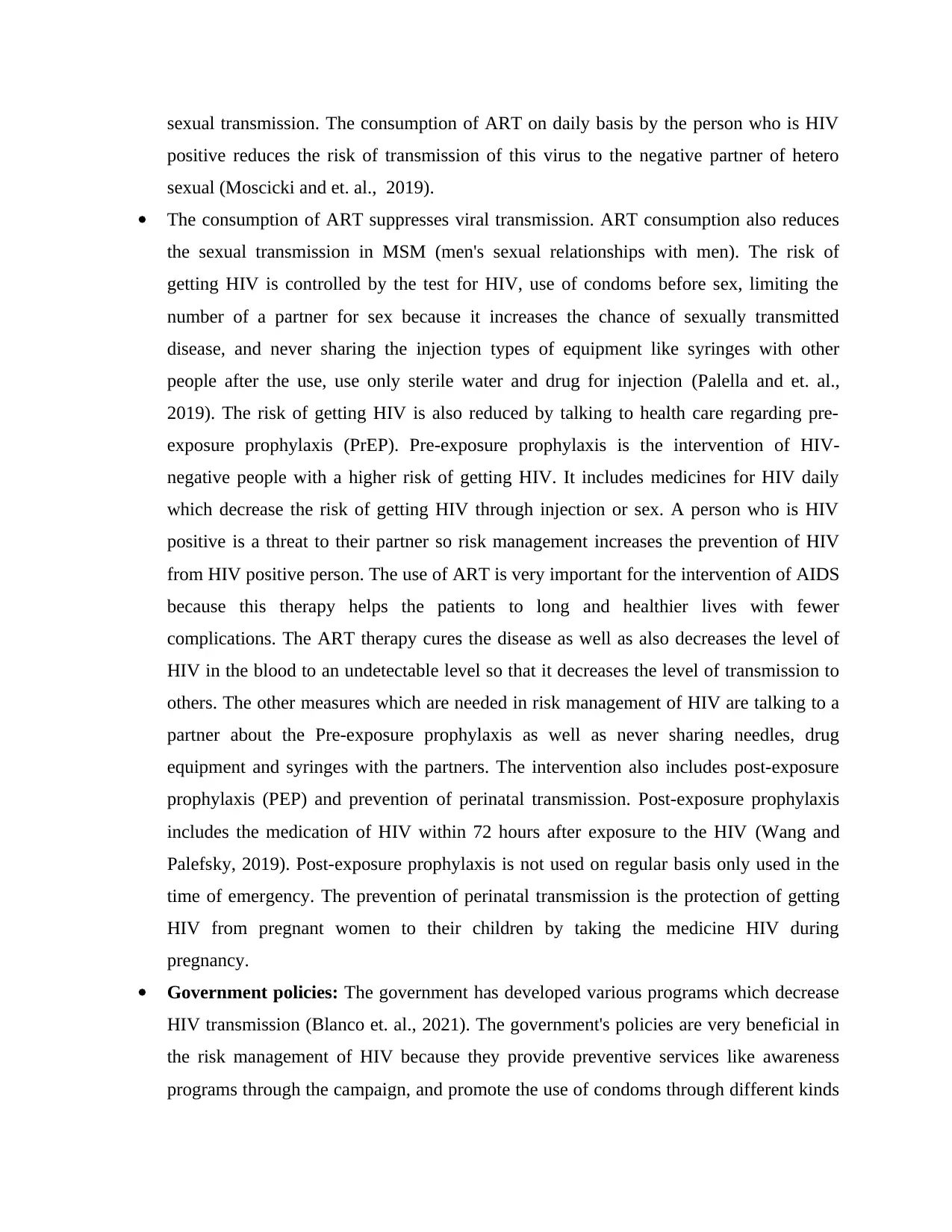
sexual transmission. The consumption of ART on daily basis by the person who is HIV
positive reduces the risk of transmission of this virus to the negative partner of hetero
sexual (Moscicki and et. al., 2019).
The consumption of ART suppresses viral transmission. ART consumption also reduces
the sexual transmission in MSM (men's sexual relationships with men). The risk of
getting HIV is controlled by the test for HIV, use of condoms before sex, limiting the
number of a partner for sex because it increases the chance of sexually transmitted
disease, and never sharing the injection types of equipment like syringes with other
people after the use, use only sterile water and drug for injection (Palella and et. al.,
2019). The risk of getting HIV is also reduced by talking to health care regarding pre-
exposure prophylaxis (PrEP). Pre-exposure prophylaxis is the intervention of HIV-
negative people with a higher risk of getting HIV. It includes medicines for HIV daily
which decrease the risk of getting HIV through injection or sex. A person who is HIV
positive is a threat to their partner so risk management increases the prevention of HIV
from HIV positive person. The use of ART is very important for the intervention of AIDS
because this therapy helps the patients to long and healthier lives with fewer
complications. The ART therapy cures the disease as well as also decreases the level of
HIV in the blood to an undetectable level so that it decreases the level of transmission to
others. The other measures which are needed in risk management of HIV are talking to a
partner about the Pre-exposure prophylaxis as well as never sharing needles, drug
equipment and syringes with the partners. The intervention also includes post-exposure
prophylaxis (PEP) and prevention of perinatal transmission. Post-exposure prophylaxis
includes the medication of HIV within 72 hours after exposure to the HIV (Wang and
Palefsky, 2019). Post-exposure prophylaxis is not used on regular basis only used in the
time of emergency. The prevention of perinatal transmission is the protection of getting
HIV from pregnant women to their children by taking the medicine HIV during
pregnancy.
Government policies: The government has developed various programs which decrease
HIV transmission (Blanco et. al., 2021). The government's policies are very beneficial in
the risk management of HIV because they provide preventive services like awareness
programs through the campaign, and promote the use of condoms through different kinds
positive reduces the risk of transmission of this virus to the negative partner of hetero
sexual (Moscicki and et. al., 2019).
The consumption of ART suppresses viral transmission. ART consumption also reduces
the sexual transmission in MSM (men's sexual relationships with men). The risk of
getting HIV is controlled by the test for HIV, use of condoms before sex, limiting the
number of a partner for sex because it increases the chance of sexually transmitted
disease, and never sharing the injection types of equipment like syringes with other
people after the use, use only sterile water and drug for injection (Palella and et. al.,
2019). The risk of getting HIV is also reduced by talking to health care regarding pre-
exposure prophylaxis (PrEP). Pre-exposure prophylaxis is the intervention of HIV-
negative people with a higher risk of getting HIV. It includes medicines for HIV daily
which decrease the risk of getting HIV through injection or sex. A person who is HIV
positive is a threat to their partner so risk management increases the prevention of HIV
from HIV positive person. The use of ART is very important for the intervention of AIDS
because this therapy helps the patients to long and healthier lives with fewer
complications. The ART therapy cures the disease as well as also decreases the level of
HIV in the blood to an undetectable level so that it decreases the level of transmission to
others. The other measures which are needed in risk management of HIV are talking to a
partner about the Pre-exposure prophylaxis as well as never sharing needles, drug
equipment and syringes with the partners. The intervention also includes post-exposure
prophylaxis (PEP) and prevention of perinatal transmission. Post-exposure prophylaxis
includes the medication of HIV within 72 hours after exposure to the HIV (Wang and
Palefsky, 2019). Post-exposure prophylaxis is not used on regular basis only used in the
time of emergency. The prevention of perinatal transmission is the protection of getting
HIV from pregnant women to their children by taking the medicine HIV during
pregnancy.
Government policies: The government has developed various programs which decrease
HIV transmission (Blanco et. al., 2021). The government's policies are very beneficial in
the risk management of HIV because they provide preventive services like awareness
programs through the campaign, and promote the use of condoms through different kinds
⊘ This is a preview!⊘
Do you want full access?
Subscribe today to unlock all pages.

Trusted by 1+ million students worldwide
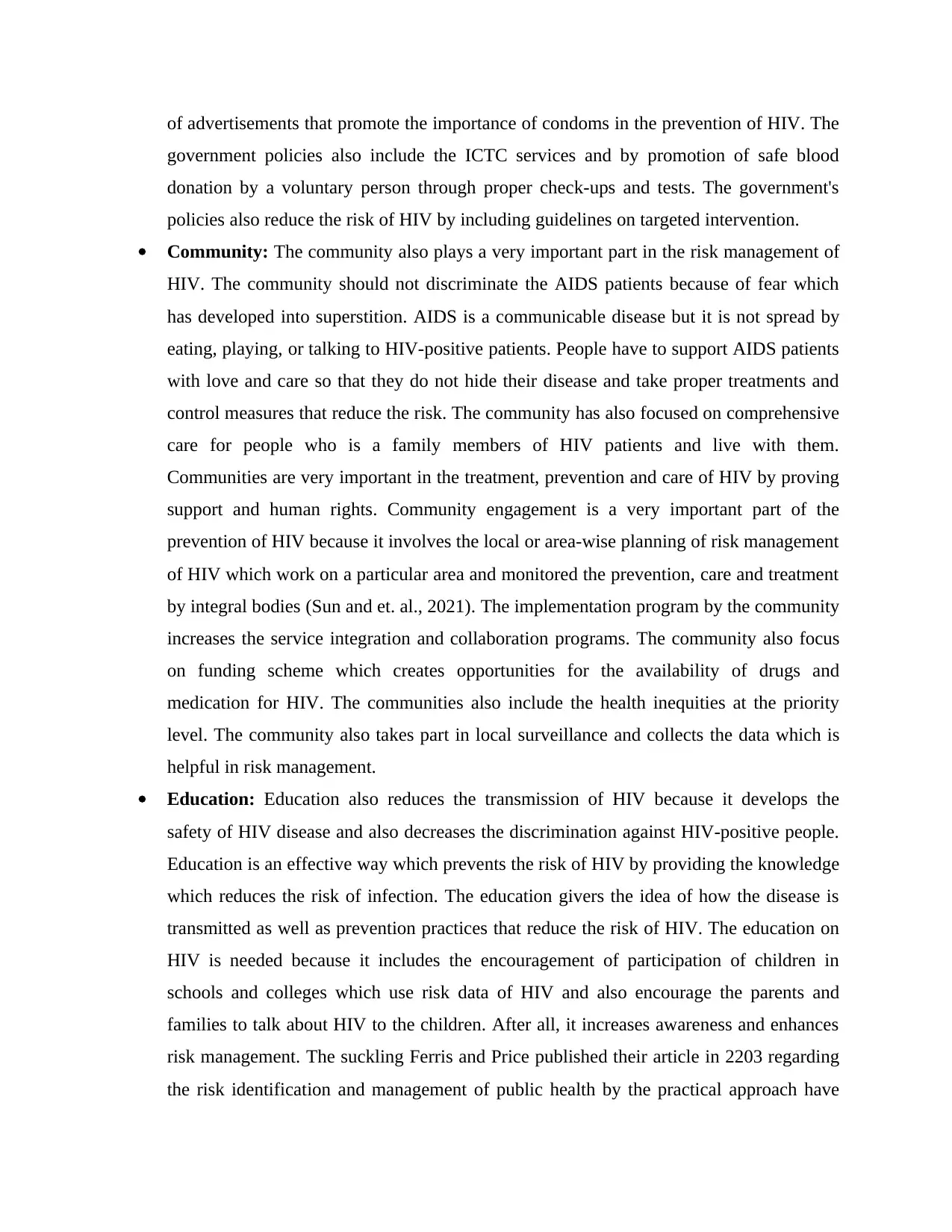
of advertisements that promote the importance of condoms in the prevention of HIV. The
government policies also include the ICTC services and by promotion of safe blood
donation by a voluntary person through proper check-ups and tests. The government's
policies also reduce the risk of HIV by including guidelines on targeted intervention.
Community: The community also plays a very important part in the risk management of
HIV. The community should not discriminate the AIDS patients because of fear which
has developed into superstition. AIDS is a communicable disease but it is not spread by
eating, playing, or talking to HIV-positive patients. People have to support AIDS patients
with love and care so that they do not hide their disease and take proper treatments and
control measures that reduce the risk. The community has also focused on comprehensive
care for people who is a family members of HIV patients and live with them.
Communities are very important in the treatment, prevention and care of HIV by proving
support and human rights. Community engagement is a very important part of the
prevention of HIV because it involves the local or area-wise planning of risk management
of HIV which work on a particular area and monitored the prevention, care and treatment
by integral bodies (Sun and et. al., 2021). The implementation program by the community
increases the service integration and collaboration programs. The community also focus
on funding scheme which creates opportunities for the availability of drugs and
medication for HIV. The communities also include the health inequities at the priority
level. The community also takes part in local surveillance and collects the data which is
helpful in risk management.
Education: Education also reduces the transmission of HIV because it develops the
safety of HIV disease and also decreases the discrimination against HIV-positive people.
Education is an effective way which prevents the risk of HIV by providing the knowledge
which reduces the risk of infection. The education givers the idea of how the disease is
transmitted as well as prevention practices that reduce the risk of HIV. The education on
HIV is needed because it includes the encouragement of participation of children in
schools and colleges which use risk data of HIV and also encourage the parents and
families to talk about HIV to the children. After all, it increases awareness and enhances
risk management. The suckling Ferris and Price published their article in 2203 regarding
the risk identification and management of public health by the practical approach have
government policies also include the ICTC services and by promotion of safe blood
donation by a voluntary person through proper check-ups and tests. The government's
policies also reduce the risk of HIV by including guidelines on targeted intervention.
Community: The community also plays a very important part in the risk management of
HIV. The community should not discriminate the AIDS patients because of fear which
has developed into superstition. AIDS is a communicable disease but it is not spread by
eating, playing, or talking to HIV-positive patients. People have to support AIDS patients
with love and care so that they do not hide their disease and take proper treatments and
control measures that reduce the risk. The community has also focused on comprehensive
care for people who is a family members of HIV patients and live with them.
Communities are very important in the treatment, prevention and care of HIV by proving
support and human rights. Community engagement is a very important part of the
prevention of HIV because it involves the local or area-wise planning of risk management
of HIV which work on a particular area and monitored the prevention, care and treatment
by integral bodies (Sun and et. al., 2021). The implementation program by the community
increases the service integration and collaboration programs. The community also focus
on funding scheme which creates opportunities for the availability of drugs and
medication for HIV. The communities also include the health inequities at the priority
level. The community also takes part in local surveillance and collects the data which is
helpful in risk management.
Education: Education also reduces the transmission of HIV because it develops the
safety of HIV disease and also decreases the discrimination against HIV-positive people.
Education is an effective way which prevents the risk of HIV by providing the knowledge
which reduces the risk of infection. The education givers the idea of how the disease is
transmitted as well as prevention practices that reduce the risk of HIV. The education on
HIV is needed because it includes the encouragement of participation of children in
schools and colleges which use risk data of HIV and also encourage the parents and
families to talk about HIV to the children. After all, it increases awareness and enhances
risk management. The suckling Ferris and Price published their article in 2203 regarding
the risk identification and management of public health by the practical approach have
Paraphrase This Document
Need a fresh take? Get an instant paraphrase of this document with our AI Paraphraser
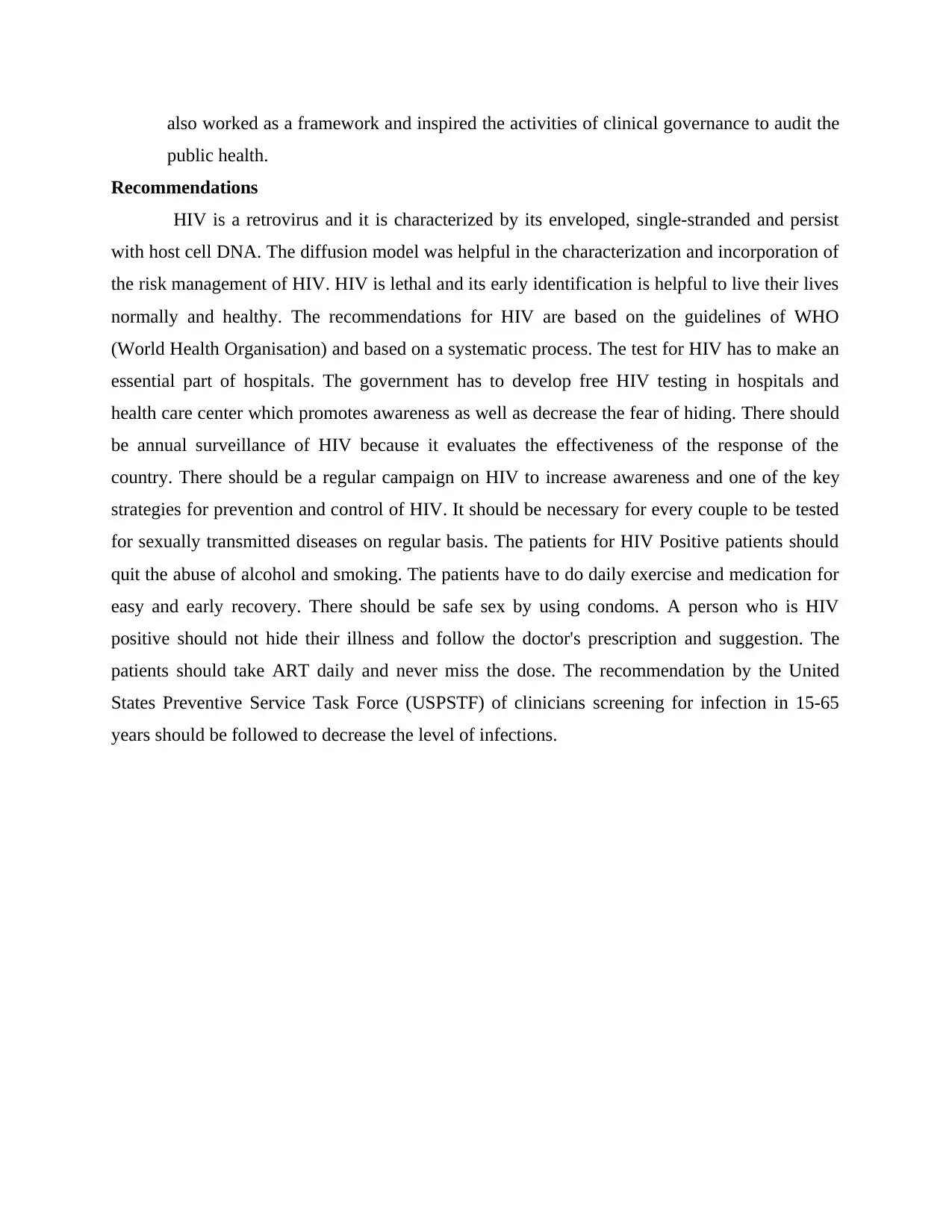
also worked as a framework and inspired the activities of clinical governance to audit the
public health.
Recommendations
HIV is a retrovirus and it is characterized by its enveloped, single-stranded and persist
with host cell DNA. The diffusion model was helpful in the characterization and incorporation of
the risk management of HIV. HIV is lethal and its early identification is helpful to live their lives
normally and healthy. The recommendations for HIV are based on the guidelines of WHO
(World Health Organisation) and based on a systematic process. The test for HIV has to make an
essential part of hospitals. The government has to develop free HIV testing in hospitals and
health care center which promotes awareness as well as decrease the fear of hiding. There should
be annual surveillance of HIV because it evaluates the effectiveness of the response of the
country. There should be a regular campaign on HIV to increase awareness and one of the key
strategies for prevention and control of HIV. It should be necessary for every couple to be tested
for sexually transmitted diseases on regular basis. The patients for HIV Positive patients should
quit the abuse of alcohol and smoking. The patients have to do daily exercise and medication for
easy and early recovery. There should be safe sex by using condoms. A person who is HIV
positive should not hide their illness and follow the doctor's prescription and suggestion. The
patients should take ART daily and never miss the dose. The recommendation by the United
States Preventive Service Task Force (USPSTF) of clinicians screening for infection in 15-65
years should be followed to decrease the level of infections.
public health.
Recommendations
HIV is a retrovirus and it is characterized by its enveloped, single-stranded and persist
with host cell DNA. The diffusion model was helpful in the characterization and incorporation of
the risk management of HIV. HIV is lethal and its early identification is helpful to live their lives
normally and healthy. The recommendations for HIV are based on the guidelines of WHO
(World Health Organisation) and based on a systematic process. The test for HIV has to make an
essential part of hospitals. The government has to develop free HIV testing in hospitals and
health care center which promotes awareness as well as decrease the fear of hiding. There should
be annual surveillance of HIV because it evaluates the effectiveness of the response of the
country. There should be a regular campaign on HIV to increase awareness and one of the key
strategies for prevention and control of HIV. It should be necessary for every couple to be tested
for sexually transmitted diseases on regular basis. The patients for HIV Positive patients should
quit the abuse of alcohol and smoking. The patients have to do daily exercise and medication for
easy and early recovery. There should be safe sex by using condoms. A person who is HIV
positive should not hide their illness and follow the doctor's prescription and suggestion. The
patients should take ART daily and never miss the dose. The recommendation by the United
States Preventive Service Task Force (USPSTF) of clinicians screening for infection in 15-65
years should be followed to decrease the level of infections.
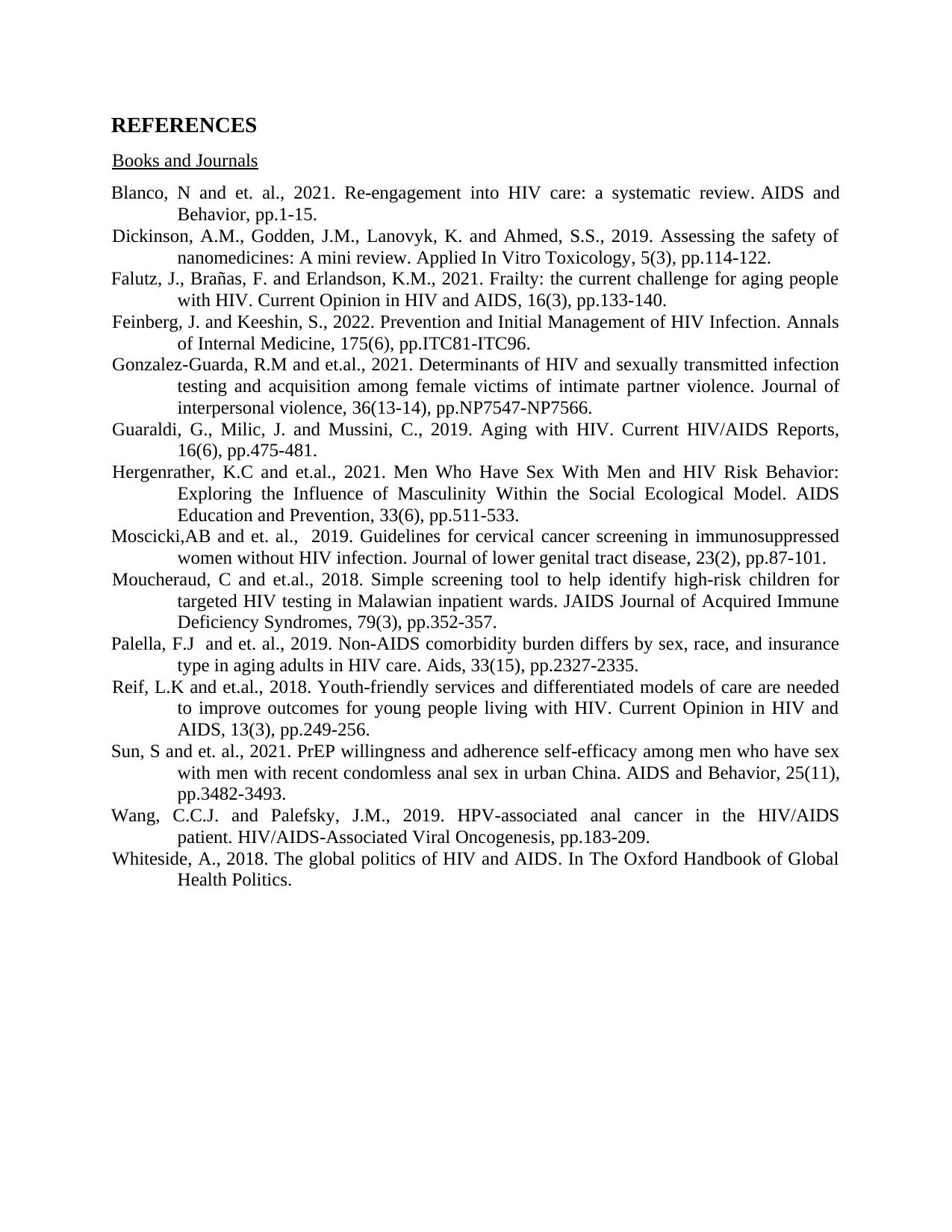
REFERENCES
Books and Journals
Blanco, N and et. al., 2021. Re-engagement into HIV care: a systematic review. AIDS and
Behavior, pp.1-15.
Dickinson, A.M., Godden, J.M., Lanovyk, K. and Ahmed, S.S., 2019. Assessing the safety of
nanomedicines: A mini review. Applied In Vitro Toxicology, 5(3), pp.114-122.
Falutz, J., Brañas, F. and Erlandson, K.M., 2021. Frailty: the current challenge for aging people
with HIV. Current Opinion in HIV and AIDS, 16(3), pp.133-140.
Feinberg, J. and Keeshin, S., 2022. Prevention and Initial Management of HIV Infection. Annals
of Internal Medicine, 175(6), pp.ITC81-ITC96.
Gonzalez-Guarda, R.M and et.al., 2021. Determinants of HIV and sexually transmitted infection
testing and acquisition among female victims of intimate partner violence. Journal of
interpersonal violence, 36(13-14), pp.NP7547-NP7566.
Guaraldi, G., Milic, J. and Mussini, C., 2019. Aging with HIV. Current HIV/AIDS Reports,
16(6), pp.475-481.
Hergenrather, K.C and et.al., 2021. Men Who Have Sex With Men and HIV Risk Behavior:
Exploring the Influence of Masculinity Within the Social Ecological Model. AIDS
Education and Prevention, 33(6), pp.511-533.
Moscicki,AB and et. al., 2019. Guidelines for cervical cancer screening in immunosuppressed
women without HIV infection. Journal of lower genital tract disease, 23(2), pp.87-101.
Moucheraud, C and et.al., 2018. Simple screening tool to help identify high-risk children for
targeted HIV testing in Malawian inpatient wards. JAIDS Journal of Acquired Immune
Deficiency Syndromes, 79(3), pp.352-357.
Palella, F.J and et. al., 2019. Non-AIDS comorbidity burden differs by sex, race, and insurance
type in aging adults in HIV care. Aids, 33(15), pp.2327-2335.
Reif, L.K and et.al., 2018. Youth-friendly services and differentiated models of care are needed
to improve outcomes for young people living with HIV. Current Opinion in HIV and
AIDS, 13(3), pp.249-256.
Sun, S and et. al., 2021. PrEP willingness and adherence self-efficacy among men who have sex
with men with recent condomless anal sex in urban China. AIDS and Behavior, 25(11),
pp.3482-3493.
Wang, C.C.J. and Palefsky, J.M., 2019. HPV-associated anal cancer in the HIV/AIDS
patient. HIV/AIDS-Associated Viral Oncogenesis, pp.183-209.
Whiteside, A., 2018. The global politics of HIV and AIDS. In The Oxford Handbook of Global
Health Politics.
Books and Journals
Blanco, N and et. al., 2021. Re-engagement into HIV care: a systematic review. AIDS and
Behavior, pp.1-15.
Dickinson, A.M., Godden, J.M., Lanovyk, K. and Ahmed, S.S., 2019. Assessing the safety of
nanomedicines: A mini review. Applied In Vitro Toxicology, 5(3), pp.114-122.
Falutz, J., Brañas, F. and Erlandson, K.M., 2021. Frailty: the current challenge for aging people
with HIV. Current Opinion in HIV and AIDS, 16(3), pp.133-140.
Feinberg, J. and Keeshin, S., 2022. Prevention and Initial Management of HIV Infection. Annals
of Internal Medicine, 175(6), pp.ITC81-ITC96.
Gonzalez-Guarda, R.M and et.al., 2021. Determinants of HIV and sexually transmitted infection
testing and acquisition among female victims of intimate partner violence. Journal of
interpersonal violence, 36(13-14), pp.NP7547-NP7566.
Guaraldi, G., Milic, J. and Mussini, C., 2019. Aging with HIV. Current HIV/AIDS Reports,
16(6), pp.475-481.
Hergenrather, K.C and et.al., 2021. Men Who Have Sex With Men and HIV Risk Behavior:
Exploring the Influence of Masculinity Within the Social Ecological Model. AIDS
Education and Prevention, 33(6), pp.511-533.
Moscicki,AB and et. al., 2019. Guidelines for cervical cancer screening in immunosuppressed
women without HIV infection. Journal of lower genital tract disease, 23(2), pp.87-101.
Moucheraud, C and et.al., 2018. Simple screening tool to help identify high-risk children for
targeted HIV testing in Malawian inpatient wards. JAIDS Journal of Acquired Immune
Deficiency Syndromes, 79(3), pp.352-357.
Palella, F.J and et. al., 2019. Non-AIDS comorbidity burden differs by sex, race, and insurance
type in aging adults in HIV care. Aids, 33(15), pp.2327-2335.
Reif, L.K and et.al., 2018. Youth-friendly services and differentiated models of care are needed
to improve outcomes for young people living with HIV. Current Opinion in HIV and
AIDS, 13(3), pp.249-256.
Sun, S and et. al., 2021. PrEP willingness and adherence self-efficacy among men who have sex
with men with recent condomless anal sex in urban China. AIDS and Behavior, 25(11),
pp.3482-3493.
Wang, C.C.J. and Palefsky, J.M., 2019. HPV-associated anal cancer in the HIV/AIDS
patient. HIV/AIDS-Associated Viral Oncogenesis, pp.183-209.
Whiteside, A., 2018. The global politics of HIV and AIDS. In The Oxford Handbook of Global
Health Politics.
⊘ This is a preview!⊘
Do you want full access?
Subscribe today to unlock all pages.

Trusted by 1+ million students worldwide
1 out of 12
Related Documents
Your All-in-One AI-Powered Toolkit for Academic Success.
+13062052269
info@desklib.com
Available 24*7 on WhatsApp / Email
![[object Object]](/_next/static/media/star-bottom.7253800d.svg)
Unlock your academic potential
Copyright © 2020–2025 A2Z Services. All Rights Reserved. Developed and managed by ZUCOL.





